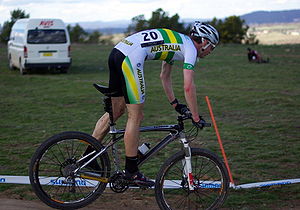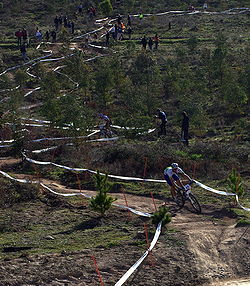
Cross-country cycling
Encyclopedia

Mountain biking
Mountain biking is a sport which consists of riding bicycles off-road, often over rough terrain, using specially adapted mountain bikes. Mountain bikes share similarities with other bikes, but incorporate features designed to enhance durability and performance in rough terrain.Mountain biking can...
. While less publicized than downhill cycling
Downhill cycling
Downhill biking is a gravity-assisted time trial mountain biking event. Riders race against the clock, usually starting at intervals of 30 seconds , on courses which typically take two to five minutes to complete. Riders come from all around the world. Riders are timed with equipment similar to...
as it is more difficult to televise, it garners the highest levels of participation both recreationally and competitively. . Cross-country cycling became an Olympic sport
Olympic sports
Olympic sports, as defined by the International Olympic Committee, are all the sports contested in the Summer and Winter Olympic Games. The Summer Olympics, as of 2012, will include 26 sports, with two additionall sports due to be added in 2016...
in 1996
1996 Summer Olympics
The 1996 Summer Olympics of Atlanta, officially known as the Games of the XXVI Olympiad and unofficially known as the Centennial Olympics, was an international multi-sport event which was celebrated in 1996 in Atlanta, Georgia, United States....
and is the only form of mountain biking practiced at the Summer Olympics.
Terrain
Cross-country cycling is defined by the terrain on which it is performed. XC courses and trails consist of a mix of rough forest paths and singletrackSingle track (mountain biking)
Single track or singletrack is a narrow mountain biking trail that is approximately the width of the bike. It contrasts with double track or fire road which is wide enough for four-wheeled off-road vehicles...
(also referred to as doubletrack depending on width), smooth fireroads
Firebreak
A firebreak is a gap in vegetation or other combustible material that acts as a barrier to slow or stop the progress of a bushfire or wildfire. A firebreak may occur naturally where there is a lack of vegetation or "fuel", such as a river, lake or canyon...
, and even paved paths connecting other trails. Riding or racing is also only deemed cross-country if the technical complexity of the trails is easy or moderate. Trails nearly impossible even to experienced riders are more often dubbed "all-mountain", "freeride", or "downhill".
Bikes and equipment

Bicycle helmet
Bicycle helmet
A bicycle helmet is a helmet intended to be worn while riding a bicycle. They are designed to attenuate impacts to the skull of a cyclist in falls while minimizing side effects such as interference with peripheral vision...
s are often used for cross-country riding. However, XC riders only rarely wear full-face helmets and do not wear the full body "armour" employed by downhill riders. Cross country cyclists are more prone to injuries than road cyclists; however, the injuries sustained by XC riders are usually not as severe.

Pound (mass)
The pound or pound-mass is a unit of mass used in the Imperial, United States customary and other systems of measurement...
). They usually feature suspension
Bicycle suspension
A bicycle suspension is the system or systems used to suspend the rider and all or part of the bicycle in order to protect them from the roughness of the terrain over which they travel...
forks
Bicycle fork
A bicycle fork is the portion of a bicycle that holds the front wheel and allows the rider to steer and balance the bicycle. A fork consists of two fork ends which hold the front wheel axle, two blades which join at a fork crown, and a steerer or steering tube to which the handlebars attach ...
in front and sometimes have suspension in the rear. In both the front and rear, most XC bicycles have approximately 100 millimeters (4 inches) of suspension travel, though some riders prefer 125-150 millimeters (5 to 6 inches) of travel as bicycle frame strength and technology advance. The geometry of the frames generally place the rider in a little more upright position than on a road bicycle
Road bicycle
The term road bicycle is used to describe bicycles built for traveling at speed on paved roads. Some sources use the term to mean racing bicycle...
but incomparably less so than on a downhill bike.
Racing

Short-track cross-country consists of many very short laps so as to be spectator-friendly.
Unlike downhill races, which are conducted in a time trial
Time trial
In many racing sports an athlete will compete in a time trial against the clock to secure the fastest time. In cycling, for example, a time trial can be a single track cycling event, or an individual or team time trial on the road, and either or both of the latter may form components of...
format, cross-country races traditionally feature a mass start
Mass start
Mass start is a format of starting in some events in athletics , such as a marathon race, speedskating or a long-distance cross country skiing competition....
or interval start, where riders are released in several large groups divided by age and/or ability. Races with very large fields that do not wish to stagger starts will sometimes employ a Le Mans start where racers begin by running to their bikes.

Union Cycliste Internationale
Union Cycliste Internationale is the world governing body for sports cycling and oversees international competitive cycling events. The UCI is based in Aigle, Switzerland....
. In the United States, it is under the purview of USACMTB
Norba
Norba, an ancient town of Latium , Italy. It is situated 1 mile northwest of the modern town of Norma, some 1575 ft. above sea-level, on the west edge of the Volscian Mountains or Monti Lepini...
a division of USA Cycling
USA Cycling
USA Cycling or USAC, based in Colorado Springs, Colorado, is the national governing body for bicycle racing in the United States. It covers the disciplines of road, track, mountain bike, cyclo-cross, BMX and collegiate racing...
. In the United Kingdom, British Cycling
British Cycling
British Cycling is the national governing body for cycle racing in Great Britain. It administers most competitive cycling in Great Britain, the Channel Islands and the Isle of Man...
is the governing body.
Wheel Size

650b bikes are still rather rare, while 29" bikes, or "29ers" are rapidly gaining in popularity, and having some success in cross-country racing. A notable boost to their popularity has been 7 time Tour de France winner Lance Armstrong racing and winning on a Gary Fisher 29er. Advantages to the larger wheel formats are better traction due to a larger tire footprint, less need for suspension due to a decreased angle of attack
Angle of attack
Angle of attack is a term used in fluid dynamics to describe the angle between a reference line on a lifting body and the vector representing the relative motion between the lifting body and the fluid through which it is moving...
, less loss of momentum and lower rolling resistance
Rolling resistance
Rolling resistance, sometimes called rolling friction or rolling drag, is the resistance that occurs when a round object such as a ball or tire rolls on a flat surface, in steady velocity straight line motion. It is caused mainly by the deformation of the object, the deformation of the surface, or...
. Disadvantages are increased weight, decreased acceleration, rider fit issues for those under 5'5", and slower handling, although handling issues are being addressed successfully in newer designs with geometry changes like steeper head tube angles and higher fork offsets.

